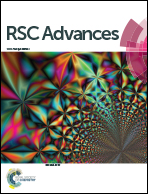Synthesis of Ag–Ni core–shell nanowires and their application in anisotropic transparent conductive films†
Abstract
We report a modified two-step method for the synthesis of highly dispersed and conductive Ag–Ni core–shell nanowires. The conductivity of the nanowire networks was improved by thermal treatment under various atmospheres. H2-thermal treatment shows superior enhancement on electrical conductivity and reduces the sheet resistance by nearly seven orders of magnitude relative to that of the pristine networks. X-Ray photoelectron spectroscopic analysis reveals that the metallic Ni0 fraction on the surface is more important to the electrical conductivity than the amount of Ni on the surface. The transparent conductive films of Ag–Ni nanowires have a sheet resistance of 220 Ω sq−1 at a transmittance of 75%, much better than those made from the pure Ni nanowires. The Ag–Ni nanowires were aligned easily by applying an external magnetic field; the anisotropic conductivity ratio for the corresponding transparent conductive films can be larger than 105. The good performance may be attributed to the fact that the as-prepared nanowires possess moderate saturation magnetization and low coercivity, alleviating the aggregation of nanowires and favoring the nanowire alignment.


 Please wait while we load your content...
Please wait while we load your content...